Deformation Characterization of Glass Fiber and Carbon Fiber-Reinforced 3D Printing Filaments Using Digital Image Correlation
Abstract
1. Introduction
- During FDM printing, the individual layers do not always adhere perfectly to each other, which can affect the mechanical properties of the final product [15].
- Research shows that continuous fiber-reinforced composites have better mechanical properties than their short fiber-reinforced counterparts [4].
- Glass fiber reinforcement dominates the composites industry worldwide, improving mechanical strength and durability and reducing brittleness [21].
- Studies by Begum et al. [23] have shown that the printing orientation and the filling density significantly influence the strength of 3D printed GF/PLA composites.
2. Materials and Methods
2.1. Filaments
2.2. 3D Printers and Printing Setups
2.3. GOM Aramis DIC System
2.4. Specimen Preparation and Speckle Pattern
3. Results and Discussion
3.1. Measurement Experience, Die Displacement Results
3.2. Results of DIC Measurements
4. Conclusions
Author Contributions
Funding
Institutional Review Board Statement
Data Availability Statement
Acknowledgments
Conflicts of Interest
List of Abbreviations
| 3D | Three-Dimension or Three-Dimensional |
| AM | Additive Manufacturing |
| CF | Carbon Fiber |
| DIC | Digital Image Correlation |
| ECT | Erichsen Cupping Test |
| FDM | Fused Deposition Modeling |
| GF | Glass Fiber |
| LOM | Laminated Object Manufacturing |
| PA | Polyamide |
| PETG | Polyethylene Terephthalate Glycol |
| PLA | Polylactic Acid |
| SLA | Stereolithography |
| SLS | Selective Laser Sintering |
References
- Valvez, S.; Santos, P.; Parente, J.M.; Silva, M.P.; Reis, P.N.B. 3D Printed Continuous Carbon Fiber-Reinforced PLA Composites: A Short Review. Procedia Struct. Integr. 2020, 25, 394–399. [Google Scholar] [CrossRef]
- Heidari-Rarani, M.; Rafiee-Afarani, M.; Zahedi, A.M. Mechanical Characterization of FDM 3D Printing of Continuous Carbon Fiber-Reinforced PLA Composites. Compos. B Eng. 2019, 175, 107147. [Google Scholar] [CrossRef]
- Tian, X.; Liu, T.; Yang, C.; Wang, Q.; Li, D. Interface and Performance of 3D Printed Continuous Carbon Fiber-Reinforced PLA Composites. Compos. Part. A Appl. Sci. Manuf. 2016, 88, 198–205. [Google Scholar] [CrossRef]
- Maqsood, N.; Rimašauskas, M. Characterization of Carbon Fiber-Reinforced PLA Composites Manufactured by Fused Deposition Modeling. Compos. Part. C Open Access 2021, 4, 100112. [Google Scholar] [CrossRef]
- Kohutiar, M.; Kakošová, L.; Krbata, M.; Janík, R.; Fekiač, J.J.; Breznická, A.; Eckert, M.; Mikuš, P.; Timárová, Ľ. Comprehensive Review: Technological Approaches, Properties, and Applications of Pure and Reinforced Polyamide 6 (PA6) and Polyamide 12 (PA12) Composite Materials. Polymers 2025, 17, 442. [Google Scholar] [CrossRef]
- Huang, Y.; Sultan, M.T.H.; Shahar, F.S.; Grzejda, R.; Łukaszewicz, A. Hybrid Fiber-Reinforced Biocomposites for Marine Applications: A Review. J. Compos. Sci. 2024, 8, 430. [Google Scholar] [CrossRef]
- Balakrishnan, T.S.; Sultan, M.T.H.; Shahar, F.S.; Basri, A.A.; Shah, A.U.M.; Sebaey, T.A.; Łukaszewicz, A.; Józwik, J.; Grzejda, R. Fatigue and Impact Properties of Kenaf/Glass-Reinforced Hybrid Pultruded Composites for Structural Applications. Materials 2024, 17, 302. [Google Scholar] [CrossRef]
- Ézsiás, L.; Tompa, R.; Fischer, S. Investigation of the Possible Correlations Between Specific Characteristics of Crushed Stone Aggregates. Spectr. Mech. Eng. Oper. Res. 2024, 1, 10–26. [Google Scholar] [CrossRef]
- Fischer, S. Investigation of the Settlement Behavior of Ballasted Railway Tracks Due to Dynamic Loading. Spectr. Mech. Eng. Oper. Res. 2025, 2, 24–46. [Google Scholar] [CrossRef]
- Mousavi, S.M.R.; Rafe, A.; Yeganehzad, S. Textural, Mechanical, and Microstructural Properties of Restructured Pimiento Alginate-Guar Gels. J. Texture Stud. 2019, 50, 155–164. [Google Scholar] [CrossRef]
- Fischer, S.; Harangozó, D.; Németh, D.; Kocsis, B.; Sysyn, M.; Kurhan, D.; Brautigam, A. Investigation of Heat-Affected Zones of Thermite Rail Weldings. Facta Univ. Ser. Mech. Eng. 2024, 22, 689–710. [Google Scholar] [CrossRef]
- Aydin, M.; Wu, X.; Cetinkaya, K.; Yasar, M.; Kadi, I. Application of Digital Image Correlation Technique to Erichsen Cupping Test. Eng. Sci. Technol. Int. J. 2018, 21, 760–768. [Google Scholar] [CrossRef]
- Szalai, S.; Szívós, B.F.; Kocsis, D.; Sysyn, M.; Liu, J.; Fischer, S. The Application of DIC in Criminology Analysis Procedures to Measure Skin Deformation. J. Appl. Comput. Mech. 2024, 10, 817–829. [Google Scholar] [CrossRef]
- Bodnàr, Z. Unlocking Potential with AI-Designed PLA Compounds. In Proceedings of the 8th PLA World Congress 2024 Handbook, Munich, Germany, 28–29 May 2024; Volume 22. [Google Scholar]
- Yang, L.; Li, S.; Zhou, X.; Liu, J.; Li, Y.; Yang, M.; Yuan, Q.; Zhang, W. Effects of Carbon Nanotube on the Thermal, Mechanical, and Electrical Properties of PLA/CNT Printed Parts in the FDM Process. Synth. Met. 2019, 253, 122–130. [Google Scholar] [CrossRef]
- Bembenek, M.; Kowalski, Ł.; Kosoń-Schab, A. Research on the Influence of Processing Parameters on the Specific Tensile Strength of FDM Additive Manufactured PET-G and PLA Materials. Polymers 2022, 14, 2446. [Google Scholar] [CrossRef] [PubMed]
- Ibrahim, N.I.; Sultan, M.T.H.; Łukaszewicz, A.; Shah, A.U.M.; Shahar, F.S.; Józwik, J.; Najeeb, M.I.; Grzejda, R. Characterization and Isolation Method of Gigantochloa scortechinii (Buluh semantan) Cellulose Nanocrystals. Int. J. Biol. Macromol. 2024, 272, 132847. [Google Scholar] [CrossRef]
- Giani, N.; Mazzocchetti, L.; Benelli, T.; Picchioni, F.; Giorgini, L. Towards Sustainability in 3D Printing of Thermoplastic Composites: Evaluation of Recycled Carbon Fibers as Reinforcing Agent for FDM Filament Production and 3D Printing. Compos. Part. A Appl. Sci. Manuf. 2022, 159, 107002. [Google Scholar] [CrossRef]
- Shahar, F.S.; Sultan, M.T.H.; Grzejda, R.; Łukaszewicz, A.; Oksiuta, Z.; Krishnamoorthy, R.R. Harnessing the Potential of Natural Composites in Biomedical 3D Printing. Materials 2024, 17, 6045. [Google Scholar] [CrossRef]
- Rao, V.D.P.; Rajiv, P.; Geethika, V.N. Effect of Fused Deposition Modelling (FDM) Process Parameters on Tensile Strength of Carbon Fibre PLA. Mater. Today Proc. 2019, 18, 2012–2018. [Google Scholar]
- Thomason, J.L. Glass Fibre Sizing: A Review. Compos. Part. A Appl. Sci. Manuf. 2019, 127, 105619. [Google Scholar]
- Wang, G.; Zhang, D.; Wan, G.; Li, B.; Zhao, G. Glass Fiber-Reinforced PLA Composite with Enhanced Mechanical Properties, Thermal Behavior, and Foaming Ability. Polymer 2019, 181, 121803. [Google Scholar] [CrossRef]
- Vasumathi, M.; Karupaiah, V.; Narayanan, V. Effect of Process Parameters on Mechanical and Tribological Characteristics of FDM Printed Glass Fiber-Reinforced PLA Composites. Rapid Prototyp. J. 2024, 30, 1859–1875. [Google Scholar] [CrossRef]
- Liu, Z.; Lei, Q.; Xing, S. Mechanical Characteristics of Wood, Ceramic, Metal and Carbon Fiber-Based PLA Composites Fabricated by FDM. J. Mater. Res. Technol. 2019, 8, 3743–3753. [Google Scholar] [CrossRef]
- Ismail, K.I.; Pang, R.; Ahmed, R.; Yap, T.C. Tensile Properties of In Situ 3D Printed Glass Fiber-Reinforced PLA. Polymers 2023, 15, 3436. [Google Scholar] [CrossRef] [PubMed]
- Omar, N.W.Y.; Shuaib, N.A.; Hadi, M.H.J.A.; Azmi, A.I. Mechanical Properties of Carbon and Glass Fibre Reinforced Composites Produced by Additive Manufacturing: A Short Review. IOP Conf. Ser. Mater. Sci. Eng. 2019, 670, 012020. [Google Scholar]
- Goh, G.D.; Dikshit, V.; Nagalingam, A.P.; Goh, G.L.; Agarwala, S.; Sing, S.L.; Wei, J.; Yeong, W.Y. Characterization of Mechanical Properties and Fracture Mode of Additively Manufactured Carbon Fiber and Glass Fiber-reinforced Thermoplastics. Mater. Des. 2018, 137, 79–89. [Google Scholar] [CrossRef]
- Valvez, S.; Silva, A.P.; Reis, P.N.B. Compressive Behaviour of 3D-Printed PETG Composites. Aerospace 2022, 9, 124. [Google Scholar] [CrossRef]
- El Mehtedi, M.; Buonadonna, P.; El Mohtadi, R.; Loi, G.; Aymerich, F.; Carta, M. Optimizing Milling Parameters for Enhanced Machinability of 3D-Printed Materials: An Analysis of PLA, PETG, and Carbon-Fiber-Reinforced PETG. J. Manuf. Mater. Process. 2024, 8, 131. [Google Scholar] [CrossRef]
- Martins, R.F.; Branco, R.; Martins, M.; Macek, W.; Marciniak, Z.; Silva, R.; Trindade, D.; Moura, C.; Franco, M.; Malça, C. Mechanical Properties of Additively Manufactured Polymeric Materials—PLA and PETG—For Biomechanical Applications. Polymers 2024, 16, 1868. [Google Scholar] [CrossRef]
- Kadhum, A.H.; Al-Zubaidi, S.; Abdulkareem, S.S. Effect of the Infill Patterns on the Mechanical and Surface Characteristics of 3D Printing of PLA, PLA+ and PETG Materials. Chemengineering 2023, 7, 46. [Google Scholar] [CrossRef]
- Srinivasan, R.; Kumar, K.N.; Ibrahim, A.J.; Anandu, K.; Gurudhevan, R. Impact of Fused Deposition Process Parameter (Infill Pattern) on the Strength of PETG Part. Mater. Today Proc. 2020, 27, 1801–1805. [Google Scholar] [CrossRef]
- Guessasma, S.; Belhabib, S. Infill Strategy in 3D Printed PLA Carbon Composites: Effect on Tensile Performance. Polymers 2022, 14, 4221. [Google Scholar] [CrossRef]
- Maqsood, N.; Rimašauskas, M. Development and Fabrication of Continuous Carbon Fiber-Reinforced Thermoplastic Porous Composite Structures with Different Infill Patterns by Using Additive Manufacturing. J. Thermoplast. Compos. Mater. 2023, 36, 2050–2075. [Google Scholar] [CrossRef]
- Mousa, M.A.; Yussof, M.M.; Hussein, T.S.; Assi, L.N.; Ghahari, S.A. A Digital Image Correlation Technique for Laboratory Structural Tests and Applications: A Systematic Literature Review. Sensors 2023, 23, 9362. [Google Scholar] [CrossRef] [PubMed]
- Guo, R.; Xian, G.; Li, C.; Hong, B. Effect of Fiber Hybrid Mode on the Tension–Tension Fatigue Performance for the Pultruded Carbon/Glass Fiber-Reinforced Polymer Composite Rod. Eng. Fract. Mech. 2022, 260, 108208. [Google Scholar] [CrossRef]
- Walotek, K.; Bzówka, J.; Ciołczyk, A. Examples of the Use of the ARAMIS 3D Measurement System for the Susceptibility to Deformation Tests for the Selected Mixtures of Coal Mining Wastes. Sensors 2021, 21, 4600. [Google Scholar] [CrossRef]
- Guastavino, R.; Göransson, P. A 3D Displacement Measurement Methodology for Anisotropic Porous Cellular Foam Materials. Polym. Test. 2007, 26, 711–719. [Google Scholar] [CrossRef]
- Samsami, S.; Pätzold, R.; Winkler, M.; Herrmann, S.; Augat, P. The Effect of Coronal Splits on the Structural Stability of Bi-Condylar Tibial Plateau Fractures: A Biomechanical Investigation. Arch. Orthop. Trauma. Surg. 2020, 140, 1719–1730. [Google Scholar] [CrossRef]
- Szalai, S.; Szürke, S.K.; Harangozó, D.; Fischer, S. Investigation of Deformations of a Lithium Polymer Cell Using the Digital Image Correlation Method (DICM). Rep. Mech. Eng. 2022, 3, 116–134. [Google Scholar] [CrossRef]




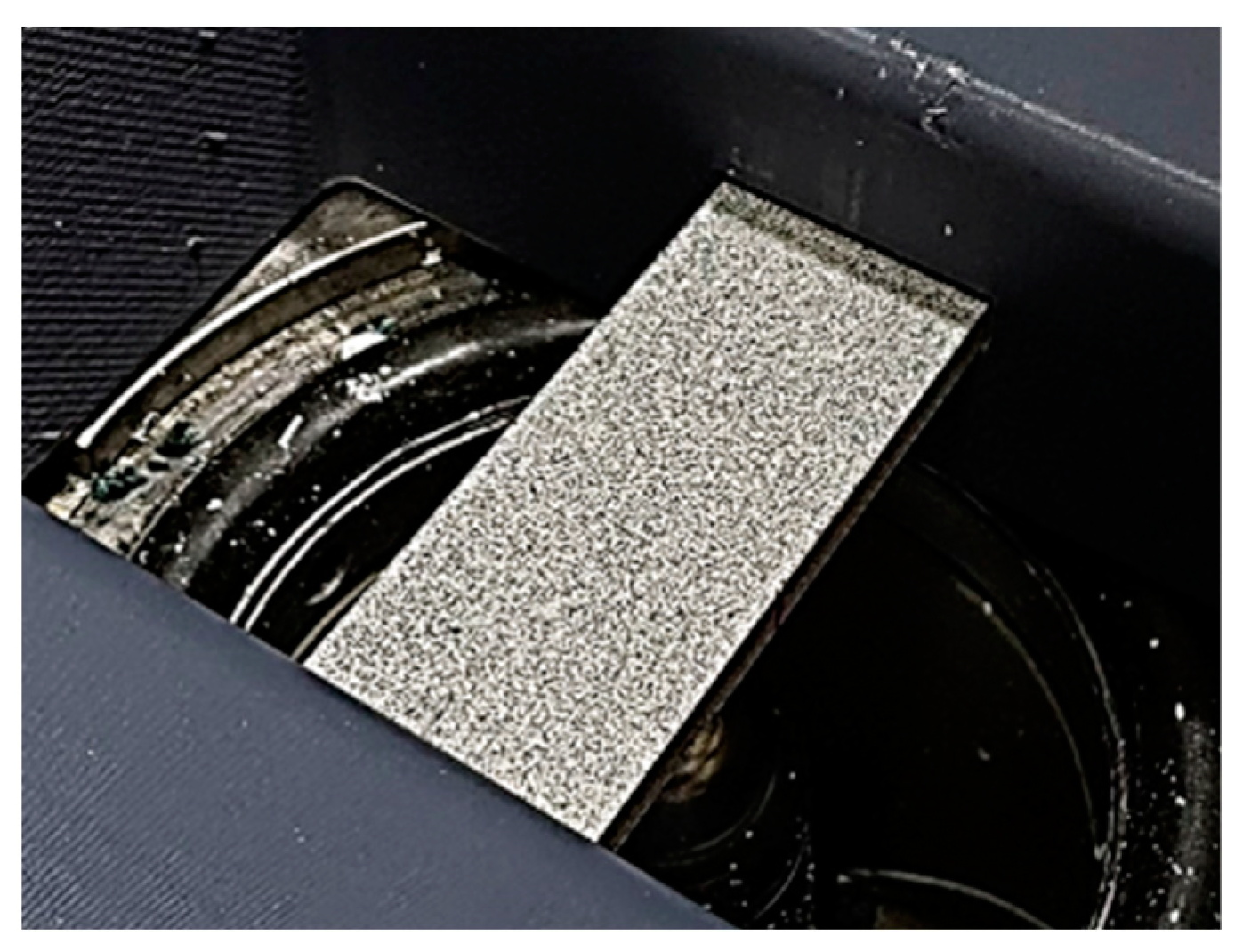

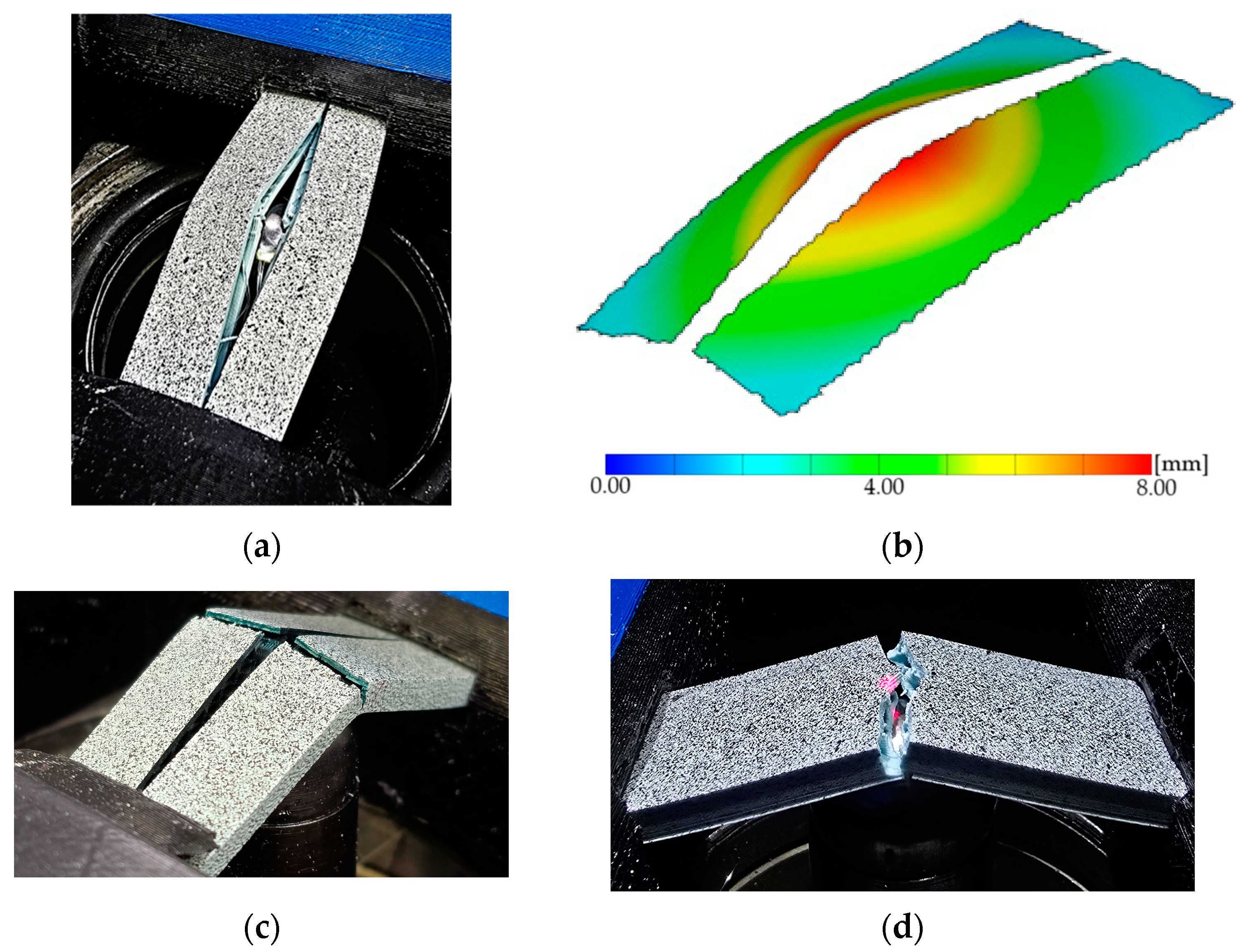
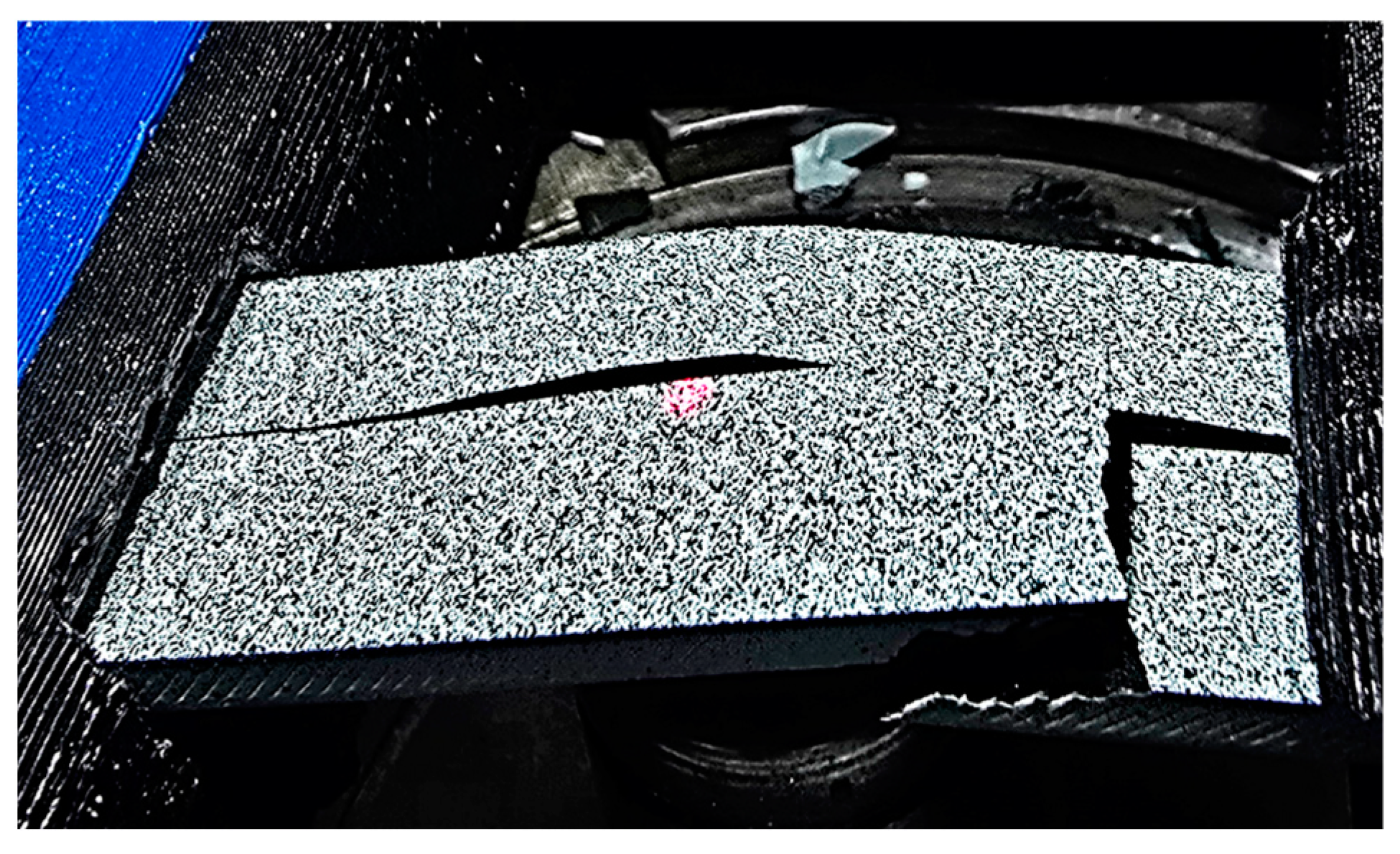

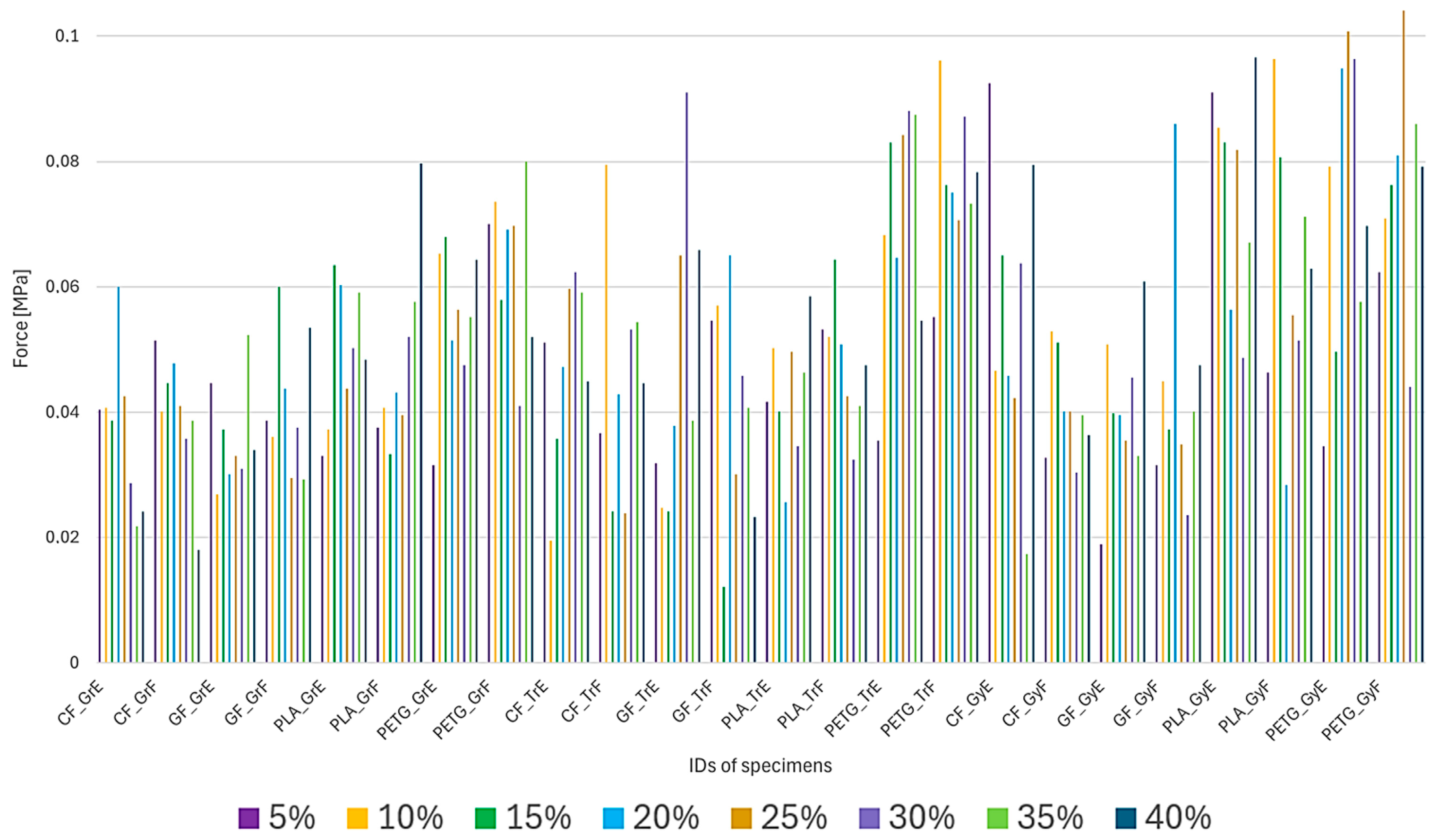


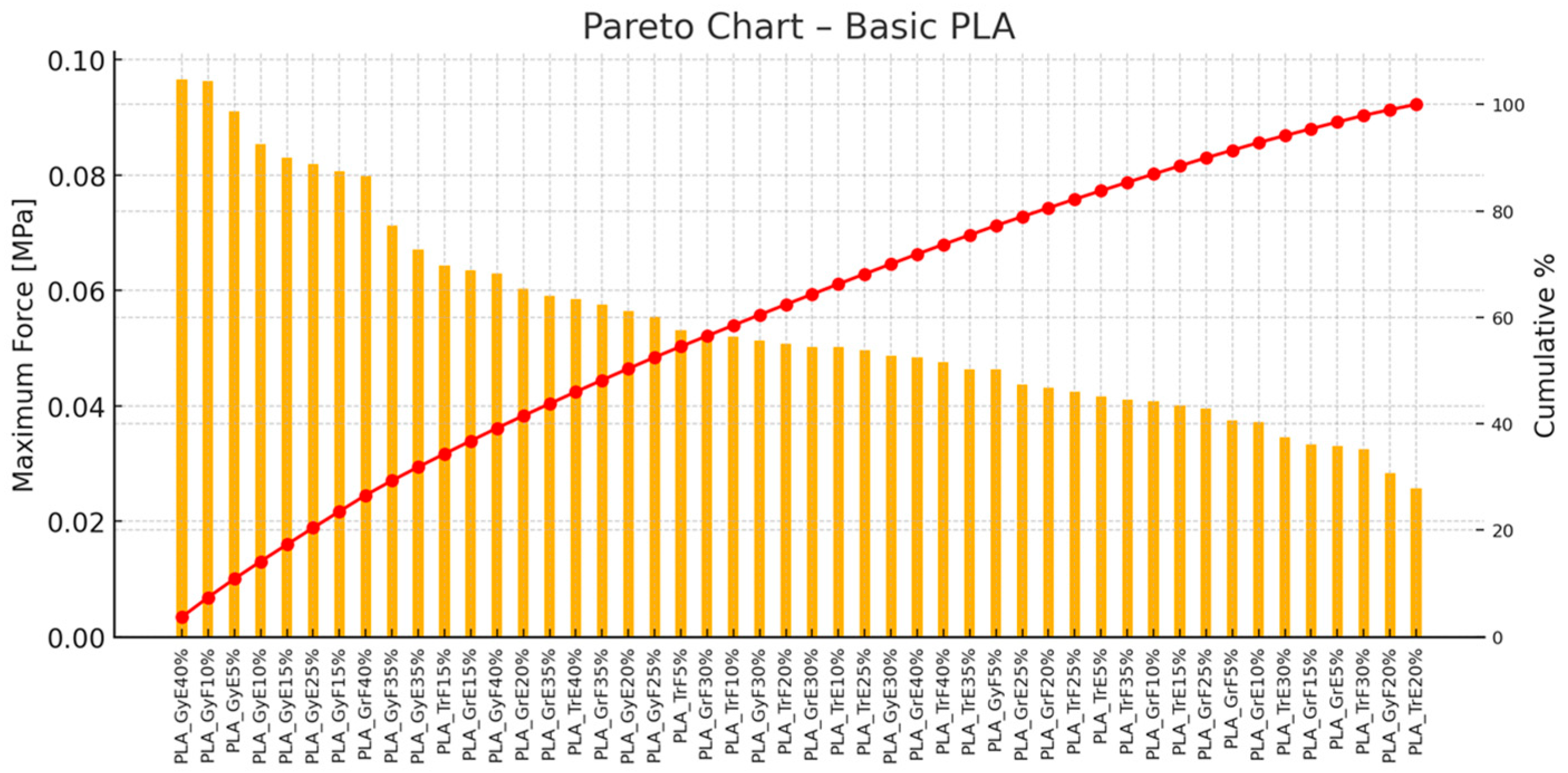
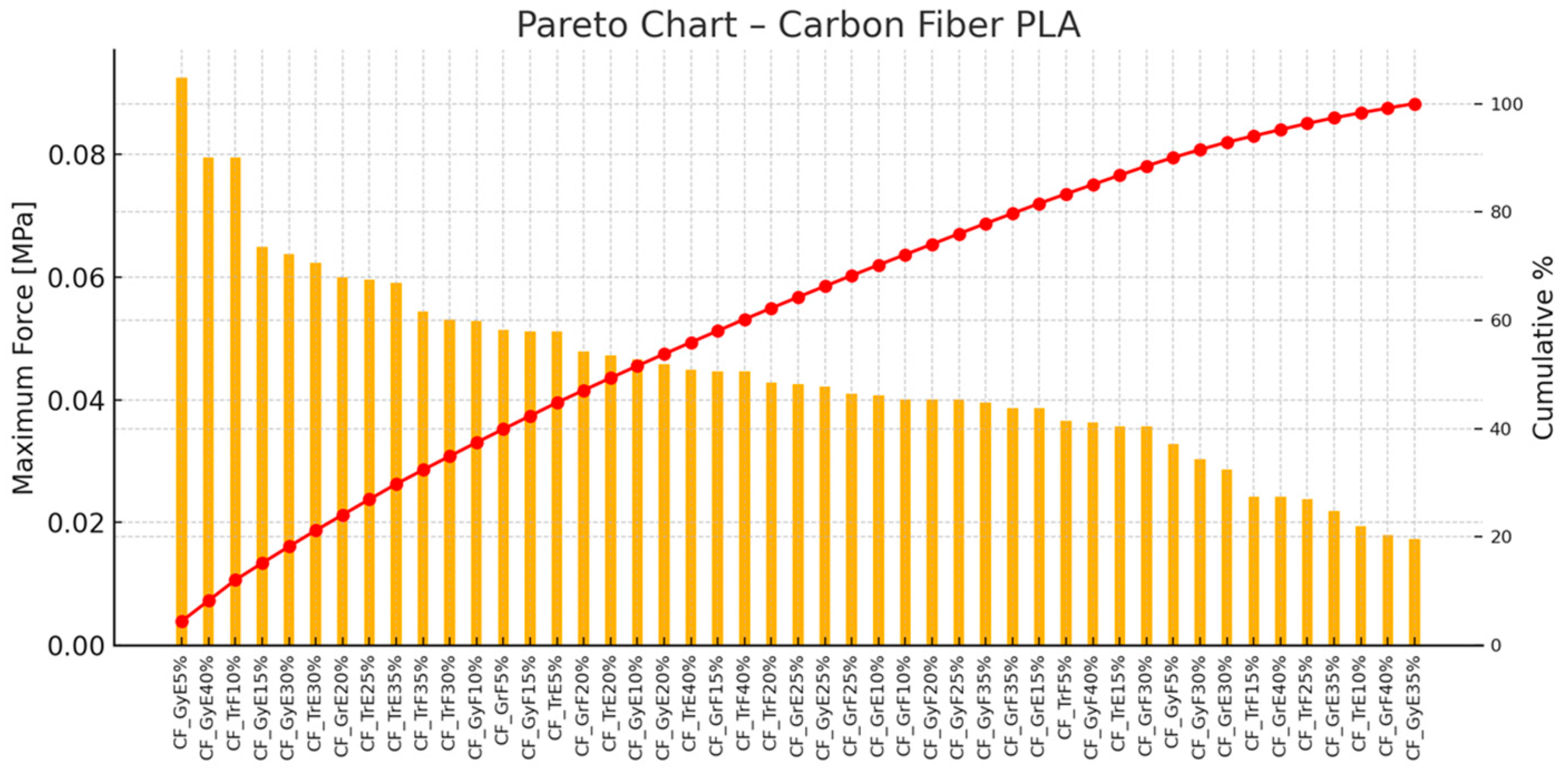

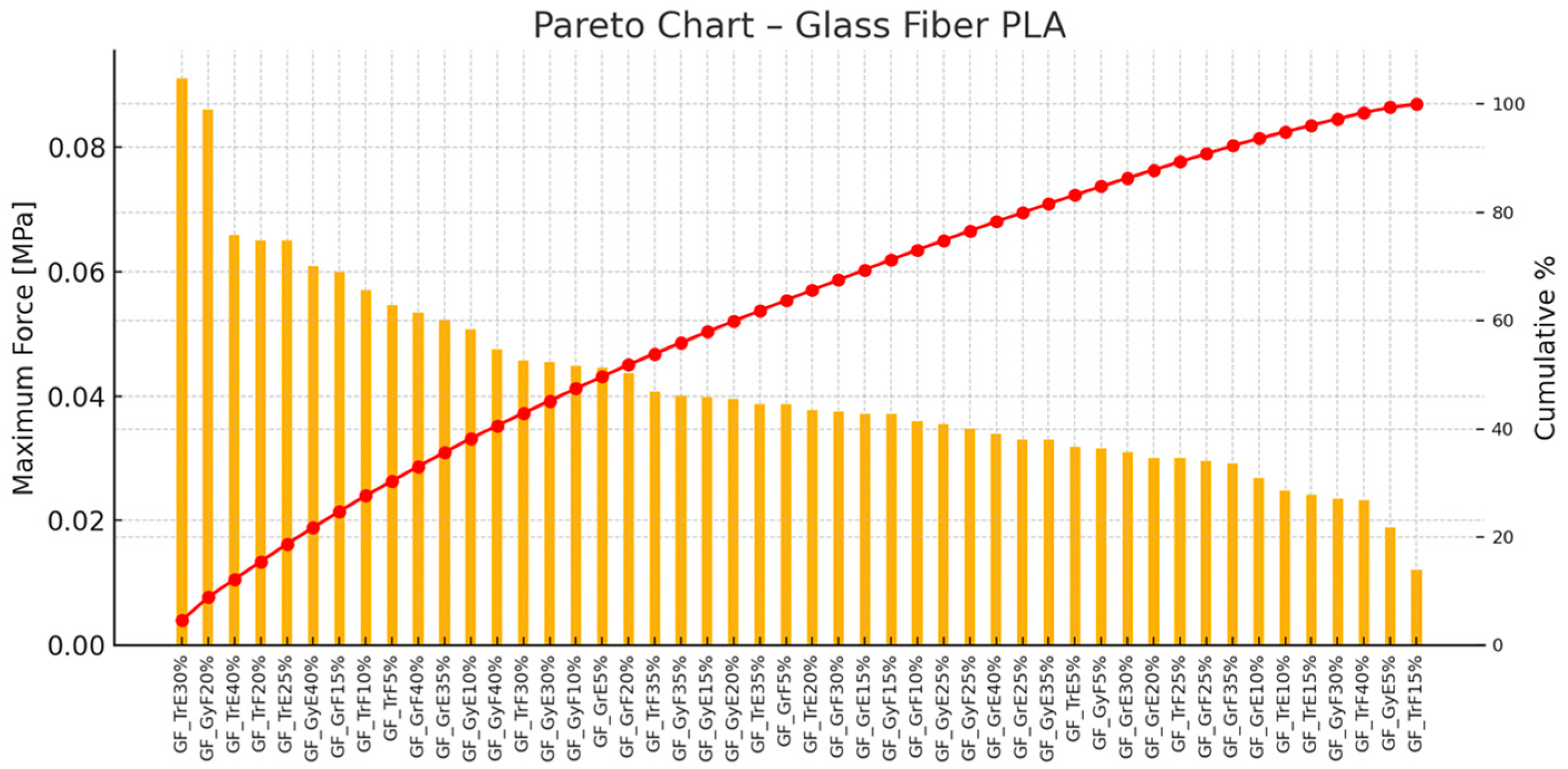

| Specific | Basic PLA | PETG | Carbon Fiber PLA | Glass Fiber PLA |
|---|---|---|---|---|
| Nozzle [°C] | 190–210 | 235–250 | 190–230 | 190–230 |
| Bed [°C] | 50–60 | 80–95 | 45–60 | 45–60 |
| Layer height [mm] | 0.4 | 0.4–1.0 | 0.4 | 0.4 |
| Max speed [mm/s] | 30–70 | 60 | 50–300 | 40–100 |
| Color | Blue | White | Green | Natural |
| Specific | Basic PLA | PETG | Carbon Fiber PLA | Glass Fiber PLA |
|---|---|---|---|---|
| Density [g/cm3] | 1.24 | 1.27 | 1.21 | 1.31 |
| Melt Flow Index [g/10 min] | 6 (210 °C/2.16kg) | - | 5.37 (190 °C/2.16 kg) | 6.36 (190 °C/2.16 kg) |
| Tensile Strength [MPa] | 60 | 50 | 39 | 59.27 |
| Elongation at Break [%] | 6 | 120 | 4.27 | 7.99 |
| Flexural Strength [MPa] | 83 | 71 | 103 | 85.01 |
| Flexural Modulus [MPa] | 3800 | 2150 | 5003 | 4414.89 |
| IZOD Impact Strength | 16 [J/m] | 85 [J/m] | 5.08 [kJ/m2] | 10.16 [kJ/m2] |
| Specific | Bambu Lab X1 Carbon | Bambu Lab A1 Mini |
|---|---|---|
| Manufacturer (city, country) | Bambu Lab (Shenzhen, China) | |
| Nozzle size [mm] | 0.4 | 0.4 |
| Extruder system | Direct drive | Direct drive |
| Filament diam. | 1.75 mm | 1.75 mm |
| Hotend | All metal | All metal |
| Bed leveling | Dual auto | Automatic |
| Infill Percentage [%] | Grid (Gr) | Triangle (Tr) | Gyroid (Gy) | |||||||||||||||||||||
|---|---|---|---|---|---|---|---|---|---|---|---|---|---|---|---|---|---|---|---|---|---|---|---|---|
| On-Edge (E) | Flat (F) | On-Edge (E) | Flat (F) | On-Edge (E) | Flat (F) | |||||||||||||||||||
| 1 | 2 | 3 | 4 | 1 | 2 | 3 | 4 | 1 | 2 | 3 | 4 | 1 | 2 | 3 | 4 | 1 | 2 | 3 | 4 | 1 | 2 | 3 | 4 | |
| 5 | + | + | + | + | + | + | + | + | + | + | + | + | + | + | + | + | + | + | + | + | + | + | + | + |
| 10 | + | + | + | + | + | + | + | + | + | + | + | + | + | + | + | + | + | + | + | + | + | + | + | + |
| 15 | + | + | + | + | + | + | + | + | + | + | + | + | + | + | + | + | + | + | + | + | + | + | + | + |
| 20 | + | + | + | + | + | + | + | + | + | + | + | + | + | + | + | + | + | + | + | + | + | + | + | + |
| 25 | + | + | + | + | + | + | + | + | + | + | + | + | + | + | + | + | + | + | + | + | + | + | + | + |
| 30 | + | + | + | + | + | + | + | + | + | + | + | + | + | + | + | + | + | + | + | + | + | + | + | + |
| 35 | + | + | + | + | + | + | + | + | + | + | + | + | + | + | + | + | + | + | + | + | + | + | + | + |
| 40 | + | + | + | + | + | + | + | + | + | + | + | + | + | + | + | + | + | + | + | + | + | + | + | + |
| PLA | Grid (Gr) | Triangle (Tr) | Gyroid (Gy) | PETG | Grid (Gr) | Triangle (Tr) | Gyroid (Gy) | ||||||
| % | On-Edge (E) | Flat (F) | On-Edge (E) | Flat (F) | On-Edge (E) | Flat (F) | % | On-Edge (E) | Flat (F) | On-Edge (E) | Flat (F) | On-Edge (E) | Flat (F) |
| 5 | 27.5 | 27.3 | 26.7 | 28.1 | 30.8 | 30.6 | 5.0 | 40.1 | 27.9 | 28.2 | 31.2 | 30.0 | 41.3 |
| 10 | 26.8 | 27.4 | 26.5 | 28.7 | 35.3 | 30.6 | 10.0 | 40.6 | 41.0 | 41.5 | 41.0 | 41.2 | 41.2 |
| 15 | 29.3 | 27.3 | 28.3 | 27.9 | 35.7 | 29.8 | 15.0 | 37.3 | 37.6 | 41.3 | 41.3 | 30.4 | 41.4 |
| 20 | 29.0 | 26.8 | 27.3 | 27.8 | 35.8 | 27.7 | 20.0 | 40.1 | 39.8 | 41.3 | 39.6 | 41.3 | 40.5 |
| 25 | 27.9 | 27.3 | 27.1 | 27.3 | 29.7 | 27.7 | 25.0 | 40.1 | 37.2 | 41.3 | 34.7 | 41.3 | 40.4 |
| 30 | 29.2 | 27.1 | 27.7 | 27.4 | 29.0 | 27.3 | 30.0 | 40.2 | 41.4 | 41.0 | 37.3 | 41.4 | 33.8 |
| 35 | 29.5 | 27.4 | 27.9 | 27.4 | 28.3 | 27.5 | 35.0 | 40.5 | 41.0 | 41.0 | 40.0 | 41.3 | 37.5 |
| 40 | 29.7 | 27.5 | 28.3 | 27.5 | 28.5 | 27.1 | 40.0 | 40.6 | 40.1 | 36.7 | 36.3 | 41.3 | 37.8 |
| GLASS | Grid (Gr) | Triangle (Tr) | Gyroid (Gy) | CARBON | Grid (Gr) | Triangle (Tr) | Gyroid (Gy) | ||||||
| % | On-Edge (E) | Flat (F) | On-Edge (E) | Flat (F) | On-Edge (E) | Flat (F) | % | On-Edge (E) | Flat (F) | On-Edge (E) | Flat (F) | On-Edge (E) | Flat (F) |
| 5 | 25.6 | 28.7 | 25.6 | 26.9 | 25.7 | 26.0 | 5.0 | 25.5 | 27.1 | 26.1 | 26.8 | 25.8 | 27.5 |
| 10 | 25.4 | 27.3 | 25.8 | 27.0 | 25.8 | 25.9 | 10.0 | 25.5 | 26.8 | 25.9 | 26.8 | 25.6 | 27.8 |
| 15 | 25.4 | 26.8 | 25.8 | 26.7 | 25.2 | 25.8 | 15.0 | 26.0 | 26.7 | 26.4 | 26.6 | 26.1 | 27.4 |
| 20 | 25.8 | 26.9 | 26.2 | 26.8 | 25.2 | 25.7 | 20.0 | 26.5 | 28.5 | 26.1 | 26.8 | 25.7 | 27.5 |
| 25 | 25.9 | 26.2 | 26.1 | 26.6 | 25.2 | 25.7 | 25.0 | 27.1 | 26.9 | 26.8 | 26.7 | 25.8 | 27.2 |
| 30 | 25.7 | 26.5 | 25.9 | 26.6 | 25.6 | 25.8 | 30.0 | 27.8 | 27.3 | 27.1 | 26.8 | 26.4 | 27.4 |
| 35 | 25.7 | 26.4 | 26.1 | 26.9 | 25.7 | 25.8 | 35.0 | 29.1 | 27.5 | 27.5 | 26.3 | 26.0 | 27.0 |
| 40 | 25.6 | 26.7 | 26.0 | 26.7 | 25.7 | 25.8 | 40.0 | 28.7 | 28.8 | 26.8 | 27.1 | 26.8 | 27.1 |
Disclaimer/Publisher’s Note: The statements, opinions and data contained in all publications are solely those of the individual author(s) and contributor(s) and not of MDPI and/or the editor(s). MDPI and/or the editor(s) disclaim responsibility for any injury to people or property resulting from any ideas, methods, instructions or products referred to in the content. |
© 2025 by the authors. Licensee MDPI, Basel, Switzerland. This article is an open access article distributed under the terms and conditions of the Creative Commons Attribution (CC BY) license (https://creativecommons.org/licenses/by/4.0/).
Share and Cite
Nemes, V.; Szalai, S.; Szívós, B.F.; Sysyn, M.; Kurhan, D.; Fischer, S. Deformation Characterization of Glass Fiber and Carbon Fiber-Reinforced 3D Printing Filaments Using Digital Image Correlation. Polymers 2025, 17, 934. https://doi.org/10.3390/polym17070934
Nemes V, Szalai S, Szívós BF, Sysyn M, Kurhan D, Fischer S. Deformation Characterization of Glass Fiber and Carbon Fiber-Reinforced 3D Printing Filaments Using Digital Image Correlation. Polymers. 2025; 17(7):934. https://doi.org/10.3390/polym17070934
Chicago/Turabian StyleNemes, Vivien, Szabolcs Szalai, Brigitta Fruzsina Szívós, Mykola Sysyn, Dmytro Kurhan, and Szabolcs Fischer. 2025. "Deformation Characterization of Glass Fiber and Carbon Fiber-Reinforced 3D Printing Filaments Using Digital Image Correlation" Polymers 17, no. 7: 934. https://doi.org/10.3390/polym17070934
APA StyleNemes, V., Szalai, S., Szívós, B. F., Sysyn, M., Kurhan, D., & Fischer, S. (2025). Deformation Characterization of Glass Fiber and Carbon Fiber-Reinforced 3D Printing Filaments Using Digital Image Correlation. Polymers, 17(7), 934. https://doi.org/10.3390/polym17070934









